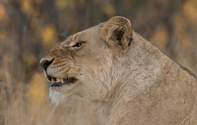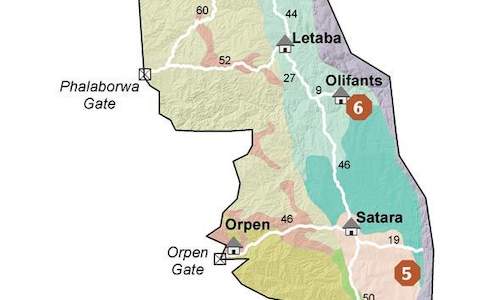
We got up at 05h00 that Sunday morning and we started our journey from Malelane gate in the most southern corner of the Kruger National Park, one of the most well known wildlife refuges in the world. As we headed due north we realized that before the sun set that night we would have traveled 450 km, all in the KNP before we reached our final destination.
We have got a deep love and appreciation for unspoiled wilderness where, for us, the main criteria is to get as far away from other people/tourists as possible. It is like being addicted to a drug, we cannot get enough of true wilderness experiences. The Nyalaland wilderness area lies in the far north of the KNP and is roughly 40 000ha in size.
It is a very harsh environment where sandstone ridges and Lebombo ironwood trees dominate. In the lower lying areas dense thickets of mopani trees and shrubs take over and along the Levuvhu River large sycomorus figs and nyalaberry trees provide food, shelter and shade to the few inhabitants of this hard and tough landscape.
After an eight and a half hour drive in the park we finally arrived at the Nyalaland wilderness base camp. This camp is very rustic and primitive with big nyalaberry trees, leadwoods and a solitary baobab that provide shade and a special atmosphere in this remote and out of the way camp. We were the only people in camp, we even asked the cook to go home and did all our own cooking and cleaning up.
Lebombo Ironwood Forests
In the week that followed we tried to do as much as possible. We got up at 04h00 every morning and started walking as soon as it was light enough to see our own feet. It was unbearably hot during the day.
One of us is used to a cold climate and he is also on his last molar. He suffered a bit. The heat drained our energy during the day but a few cold beers and a tot or two of good brandy restored and revived us in camp at night. Lebombo ironwood forests are very common in this area.
The ironwood trees are woodborer and termite resistant and those growing on the sandstone ridges are on average only 4-5 meters high. It is an extremely hard wood and it is very difficult to almost impossible to walk through these forests if it was not for the ancient elephant footpaths that cut through them.
Elephants have been using these footpaths for centuries if not longer and these ancient tracks follow the contours of the land or the easiest routes around or over obstacles. It is a well-known fact that some of the motorways that we use in Africa today were built using these old elephant tracks as guidelines.
When you walk on these well worn footpaths you cannot help feeling the anticipation and tension building because you never know when you are going to meet one of the grey giants in the thick, dense forest. On the 8th of November 1996 I led James and Patricia on a very hot day on a hard, tough trail in the Levuvhu gorge also on the Nyalaland wilderness area.
It was one of the trails that I certainly won't forget apart from the fact that wilderness conditions were perfect. It was the first time that I walked in the area and just before we left the vehicle I said I just want to take a last look at the map. James said I must take the map with. I'm glad I put my pride in my pocket and the map in my backpack because after 4 hours walking I was not lost but only temporarily disorientated.
We eventually found the valley that would take us down into the Levuvhu gorge. The scenery was breathtaking but once down in the gorge we realised we would have to cross the crocodile-infested river or retrace our steps, as the cliffs in the gorge were vertical. I took one look at Pat and decided we would just have to face the river.
Sugared fruits kept her energy up so far but would not help her much if we were to walk all the way back from where we came. Not in that heat. We crossed the river four times. Crossings one and two were through shallow ankle deep water.
The third crossing was waist deep. I realised that the last crossing was too deep and we saw four metre crocodiles lurking not too far away but we were now committed and could not turn back.
I told them that we must stay together and cross as quickly as we could. I threw a couple of stones in the direction of the crocodiles in an attempt to scare them away and we made a dash for it. Every step we took the water came up higher and on the other side we were standing in chest deep water.
The bank was muddy, slippery and steep but I pushed James out and with him pulling and me pushing we got Pat out. I slipped back but the idea of a crocodile sinking his teeth in me gave me extra strength to claw my way out. It took us a while to settle down and dry out. It was an adrenaline pumping experience of note but not to be repeated.
This time around we revisited the area and shook our heads and lifted our eyebrows when we thought about what could have happened. We also witnessed the extremes that this river can produce. In February 2000 the Levuvhu river in the gorge was 60 feet deeper than the normal flow.
To see the damage caused by such a volume of water is unbelievable and we were awed by the destructive power of the flood to the massive trees along the river. In the beginning of August 1997 on Nyalaland wilderness area, lions chased Mozambican refugees up a tree and pulled them down one by one and ate them.
This was one of many similar instances where lions caught and devoured refugees in the area. It is still happening. There are a lot of illegal immigrants moving through the Kruger National Park from Zimbabwe and Mozambique. In the winter time when all natural surface water dries up, game and refugees must make use of artificial water points. It is at these cement waterholes where lions lie and wait for their prey. .
They have learnt over time that it is easier to catch slow and weak human beings than it is to catch game like wildebeest, zebra and buffalo. Lions are opportunists and meat is meat. A lion during the day is also completely different from a lion at night.
At night they are in their element and much more bold and aggressive. Nevertheless, leading a trail on Nyalaland you always had the "man-eating" lions in the back of your mind. We planned to sleep out under the stars but it never materialized, as the lions seemed to bother one of us more so than the other.
Spectacular Scenery
The scenery in this wild area is spectacular. One cannot help but think of this area as a harsh, tough, dry but green desert. The baobab trees that litter the valleys and crests stand out like living statues, planted at the beginning of time. Some of these baobabs are enormous with girths of 25 - 30 metres.
One of the largest baobabs in Southern Africa has a circumference of 46.8m (152ft). They can be thousands of years old and one can just imagine what they have lived through over the years in this wild land untouched by modern man. Time stood still for them; they are grey oases that sustain
life for a lot of insects, reptiles, birds and mammals.
The bark and wood is very soft, spongy, fibrous and light. It is much favoured by elephants because of its moisture content. The water content of green wood is said to be from 40% - 75%. Elephants cause severe damage, especially during times of drought when large portions of inner trunk wood are chiselled out.
Baobabs have got the ability to regenerate stripped bark and forms lumps and bulges, which resemble congealed wax. The massive baobabs also helped us, as there was no cooler place in the heat of the day than sitting in their shade. We felt the presence of time, patience and wisdom as it oozed out of the trees and into our souls.
We were spiritually relaxed and in our own world that we created in our minds. We laid in the shade of a beautiful specimen and saw a pair of rare majestic black eagles that circled above us against a clear blue sky. We were in a trance of spiritual contentment and were once again lifted up to where the eagles soared.
By Jaco Badenhorst
Wilderness Trails Guide

 Kruger Parks walking trails map will help you to locate all the best bush walks in relation to the lodge or rest camp where you might be sta...
Kruger Parks walking trails map will help you to locate all the best bush walks in relation to the lodge or rest camp where you might be sta...